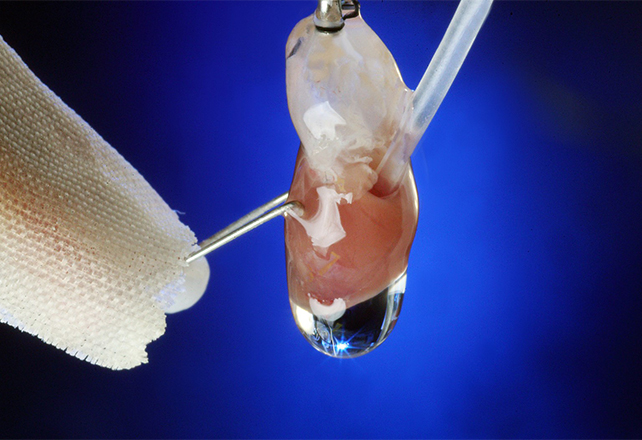Our Research

Active areas of investigation include the development of novel agents to reduce neurological injury following hypothermic circulatory arrest, the use of adenosine triphosphate - sensitive potassium (KATP) channel openers to prolong safe cardiac arrest for cardiac surgery, the investigation of the cellular and subcellular mechanisms of action of KATP channel openers to provide cardioprotection, the mechanisms involved in neurological injury during ECMO. Active research at the Johns Hopkins Cardiac Surgery Research Lab are listed below.
Basic Science Research
- Testing the safety of portable MRI with ECMO in a large animal research model
- Investigating cerebral autoregulation with laser speckle imaging in a swine model of ECMO
- Testing the impact of diazoxide on myocardial damage in an ischemic myocyte injury model
- Studying neuroprotection in a model of hypothermic circulatory arrest
Clinical Translational Research
The lab is also active in a variety of clinical research projects aimed at improving outcomes for our patients. A monthly clinical research meeting summarizes all clinical and basic science research at the division level as well as upcoming abstract deadlines for national meetings. Clinical research is supported by two excellent Research Nurses, Kate Calligy, RN, and Judi Willhide, RN. In 2018, our division produced 110 peer reviewed published articles for the literature.
Active Clinical Research
- Safety and Feasibility of Hyperkalemic Cardioplegia With Diazoxide in Cardiac Surgery (CPG-DZX) Trial
- Using urinary biomarkers to identify and eliminate intraoperative causes of acute kidney injury during cardiac surgery
- (Related to above) Relationship between delivered O2, lactate and acute kidney injury during cardiac surgery
- Clinical trial comparing low dose to standard anticoagulation in aortic and mitral mechanical valves
- Aortic valve operation outcomes in patients with Marfan syndrome
- Clinical trial on VAD safety and efficacy
- Evaluation of adequacy of outpatient opioid prescribing in cardiac surgery patients
Data Collection/Registry Studies and Multicenter Studies
- COVID-19 Critical Care Consortium / ECMOCARD
- Congenital Heart Surgeons’ Society registry
- International Severe Acute Respiratory and Emerging Infection Consortium (ISARIC)
- Database in Nutrition after CT Surgery
- Resting Energy Expenditure in ECMO
- Outcomes of COVID-19 patients on ECMO, JHH institutional experience
- Outcomes and Recovery After COVID19 Leading to ECMO (ORACLE)
- Maryland Cardiac Services Quality Initiative (MCSQI) – currently investigating the impact of timing of extubation post-cardiac surgery, impact of COVID-19 on cardiac surgery volume and outcomes, and inter-hospital cost variability of CABG
- National Cardiac Surgery Quality IMPROVE network – currently investigating the optimal timing of extubation in a national patient sample
- Prospective study comparing heparin vs. bivalrudin as the anticoagulant in patients on ECMO
- Analysis of outcomes for heart transplant patients using the UNOS database, including how comorbid diseases affect outcomes, the development of malignancies post-transplant, and the impact of mechanical circulatory support devives on outcomes
Retrospective Clinical Projects
- Effect of obesity on ECMO outcomes
- Predictive mortality scoring system for patients on VV-ECMO
- Noninvasive multimodal neuromonitoring and neurological injury in ECMO patients
- Differences in neurological outcomes between H1N1 patients and COVID-19 ECMO patients
- Impact of blood oxygen (O2) and carbon dioxide (CO2) levels on adverse outcomes in ECPR patients
- Central vs Peripheral ECMO: Different outcomes, transfusion requirements and neurological complications
- Carbon dioxide removal and neurological injury in ECMO patients
- Finding Predictors and causes of cardiac surgery ICU readmission using machine learning and causal inference
- Constructing a Machine Learning Predictive Model of 30-Day Hospital Readmission in Cardiac Surgery
Models in the Lawton Laboratory Include:
- Large animal model of hypothermic circulatory arrest
- Large animal model of cardioplegic arrest and cardiopulmonary bypass: prolonged global ischemia and left anterior descending artery infarct models
- Isolated myocyte volume and contractility model
- Isolated Langendorff heart model of prolonged global ischemia
Langendorff Heart Model at Johns Hopkins
Watch the Langendorff technique on an isolated heart model at the Johns Hopkins Cardiac Surgery Research Lab.
Cardiac Myocyte
Watch an isolated cardiac myocyte with field stimulation to assess contractility (function) in the heart.
Student Research Presentations
Watch Rosmi Thomas discuss paradoxical reduction in myocardial performance when combining two independently cardioprotective agents.











